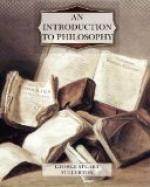As it is possible that the reader may be puzzled by differences of expression which obtain in the two books, a word of explanation is not out of place.
In the “Metaphysics,” for example, it is said that sensations so connect themselves together as to form what we call the system of material things (p. 105). It is intimated in a footnote that this is a provisional statement and the reader is referred to later chapters. Now, in the present book (sections 16-17), it is taught that we may not call material things groups of sensations.
The apparent contradiction is due to the fact that, in this volume, the full meaning of the word “sensation” is exhibited at the outset, and sensations, as phenomena of the subjective order, are distinguished from the phenomena of the objective order which constitute the external world. In the earlier work the word “sensation” was for a while used loosely to cover all our experiences that do not belong to the class called imaginary, and the distinction between the subjective and objective in this realm was drawn later (Chapter XXIII).
I think the present arrangement is the better one, as it avoids from the outset the suggestion that the real world is something subjective—our sensations or ideas—and thus escapes the idealistic flavor which almost inevitably attaches to the other treatment, until the discussion is completed, at least.
CHAPTER V, sections 10-21. See Chapters VIII and IX, “System of Metaphysics,” “The Distinction between Appearance and Reality” and “The Significance of the Distinction.”
Section 22. See Chapter XXVI, “The World as Unperceived, and the ‘Unknowable,’” where Spencer’s doctrine is examined at length, and references are given. I think it is very important that the student should realize that the “Unknowable” is a perfectly useless assumption in philosophy, and can serve no purpose whatever.
CHAPTER VI, sections 23-25. See Chapters X and XI, “System of Metaphysics,” “The Kantian Doctrine of Space” and “Difficulties connected with the Kantian Doctrine of Space.”
It would be an excellent thing for the student, after he has read the above chapters, to take up Kant’s “Critique of Pure Reason,” and read and analyze the argument of Antinomies I and II, with the Observations appended. One can understand these arguments without being familiar with the “Critique” as a whole; at any rate, the account of Kant’s philosophy contained in section 51 of this book will serve to explain his use of certain terms, such as “the laws of our sensibility.”
Kant’s reasonings are very curious and interesting in this part of his book. It seems to be proved that the world must be endless in space and without a beginning or end in time, and just as plausibly proved that it cannot be either. It seems to be proved that finite spaces and times are infinitely divisible, and at the same time that they cannot be infinitely divisible. The situation is an amusing one, and rendered not the less amusing by the seriousness with which the mutually destructive arguments are taken.




